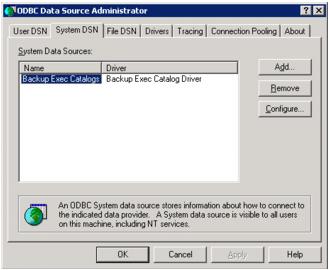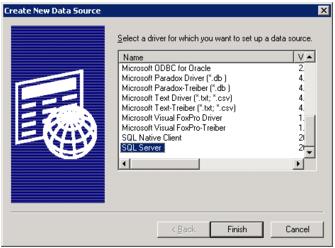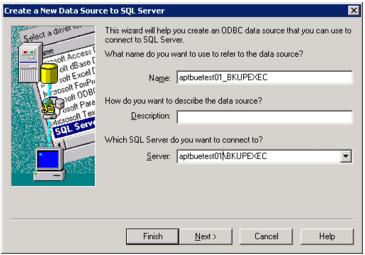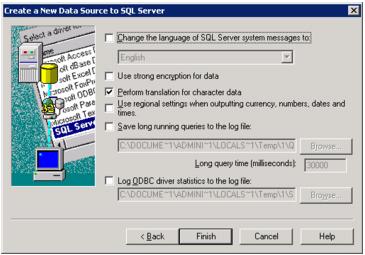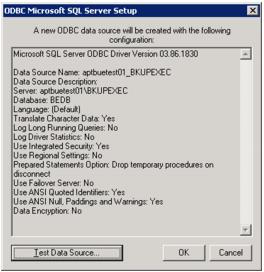Symantec Backup Exec
The issues covered in this section are relevant to Symantec Backup Exec Data Collectors.
Collecting Missed Events
Occasionally, there may be data that was missed by the scheduled Data Collection process. For example, the server may have been unavailable for a period of time. Or, you may want to capture data that was available before you actually installed the Backup Exec Data Collector software.
To capture data from a specific period, use the following utility:
buehistoricevents.{sh/bat} {AdministratorDomain} {AdministratorUser} {AdministratorPassword} [{Start Date} {End Date}] [verbose]
Where:
• Dates need to be in yyyy-mm-dd hh:mm:ss format.
• Specifying verbose will log the Backup Exec commands called to the eventcollector.log file.
Note: If the Start and End Dates are not specified, the utility will capture Events that occurred in the last 24 hours.
Substituting ODBC for JDBC to Connect to SQL Server
The Backup Exec data collector, by default, uses JDBC (Java Database Connectivity) to connect to the SQL Server database. In most cases, this is the preferred mechanism for communicating with the SQL Server. However, in some instances—for example, TCP/IP is disabled for the SQL Server—JDBC will not be feasible.
In these rare situations, you can configure ODBC (Open Database Connectivity) to connect. The main limitation of this option is that it requires that a DSN (Data Source Name) be set up for each Backup Exec server for which the data collector needs access.
Note: The data collector can be configured to use a mixture of JDBC and ODBC for specific servers.
Use the following steps to turn on ODBC for specific servers.
1. Obtain a copy the servers.csv file from the Portal Server (the one that you created to load the Backup Exec servers into the database).
2. Edit servers.csv and delete those servers that you do not want to use ODBC. The format of the entry in the CSV file is:
<windows_domain>, <host or ipaddress>, <ipaddress>, , , BKUPEXEC
3. Save the file to $APTARE_HOME/mbs/conf as odbcservers.conf on the Data Collector server.
4. Launch the ODBC Data Source Administrator window:
Control Panel > Administrative Tools > Data Sources (ODBC)
5. Set up the ODBC DSN for each of the Backup Exec servers in odbcservers.conf, as depicted in the following sequence of windows.
The DSN needs to be of the form hostname_BKUPEXEC, where hostname is the second token in odbcservers.conf.
Note: If the hostname_BKUPEXEC form does not work (see the third window in the following example), try substituting the IP address for the hostname. If you use the IP address, be sure to make appropriate changes to the CSV file to comply with the following required format:
<windows_domain>, <ipaddress>, <ipaddress>, , , BKUPEXEC
The DSN needs to be of the form hostname_BKUPEXEC, where hostname is the second token in odbcservers.conf.
Note: If the hostname_BKUPEXEC form does not work (see the third window in the following example), try substituting the IP address for the hostname. If you use the IP address, be sure to make appropriate changes to the CSV file to comply with the following required format:
<windows_domain>, <ipaddress>, <ipaddress>, , , BKUPEXEC
